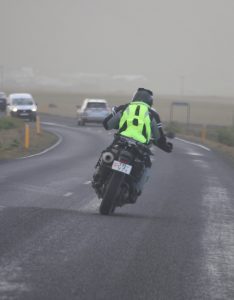Don’t let wind wind you up!
Sitting here with the bike offline, I’m looking out at the wind whipping the trees around and wishing I was riding. But not everyone likes to ride on a day like this and find the prospect of being blown about quite terrifying. Living in windy southern Alberta, I have picked up a few tips on how to make riding in the wind tolerable, or even enjoyable.

It’s not as bad as Iceland where our group had a memorable day riding from the north east corner to the southwest, enduring 110km/hr crosswinds! The downslope blasts coming off the enormous glaciers in that part of Iceland, and whistling across vast alluvial flats made life interesting. Yes, I am leaning hard right going around a left-hand bend, just to keep the bike on track.
Even more interesting was having pea gravel rattling around inside your visor, as it blasted across the road. The only thing that made it tolerable that day was that the wind was quite steady – I kept that same outwards lean all around the curve I am heading into.
So how do you handle things on a windy day? September is usually our windiest riding month so here are a few tips I have picked up.
- Squeeze the knees, not the bars: they are not called “deathgrip-bars”. It is hard to stay relaxed but if you are going to tense your muscles, do it by clamping your knees against the tank. This will improve the damping inertia effect of your body mass on what the bike is doing.
- Keep shoulders and hands soft: we tend to tense these up, fighting against the bike being pushed around. But this is counter-productive. If you relax more, you allow the gyro effect of the front wheel to do its job, and your natural balance reflexes will compensate more quickly, making everything easier. Trust that gyro effect: it is rare to be blown more than one to two feet sideways but it feels much more. Be smooth on your controls, with a little bit of push steering to help the bike tip into the wind.
- Look where you want to go: the same principle as when we tend to run wide on a corner we have entered too fast. You go where you look. This might not sound as relevant to wind riding but I have seen its effects. Last year on a group ride, we had some strong crosswinds. One newbie rider was caught unawares by the bow wave from a small truck he was overtaking and ended up crossing traffic into the left side ditch. No harm was done, just one very scared rider and an underwear change. He was convinced that he was blown clean into the ditch but it was quite clear that this was simple target fixation. You go where you look. Once spooked, he could not take his eyes off the upcoming ditch and that is where he ended up. I am convinced that you can see the same effect in this YouTube video.
Again, the rider is convinced that he was blown into the ditch but careful examination suggests that same target fixation effect.
- Be like a sailor and keep an eye on your surroundings: wind direction matters, obviously, and being blown around by gusty and changeable blasts makes life harder. You can compensate by looking for small clues such as flags, wind socks, dust devils, water ripples, which can warn you of an upcoming gust. If you are on the downwind side of trucks, you will feel the effect of their wash even more, especially from big logging trucks. Give yourself a bit more room when passing them, taking care about their bow wave and wake — imagine they are a large boat out on the water to estimate where these will be. This applies both for approaching trucks and trucks that you are following. Remember that large buildings, trees and dirt banks can also create a wind shadow to fall into, followed by an extra blast as you emerge on the other side.
- Prep for the journey: if you know you are heading into windy conditions, a little bit of prep helps. “Batten down the hatches” — cinching up loose straps, closing jacket vents, and generally tying down anything that flaps. Better not to use a top case or anything that increases your cross-sectional area. Peaks on helmets can put a strain on your neck so remove it if you can. Plan your route — headwinds and tailwinds are easier to handle than crosswinds so think ahead on whether certain legs of your journey are more likely to be windy, and whether you have an alternative.
- Riding position: tucking down behind the windshield may help, or at least reduce your frontal area on a naked bike. Don’t worry about looking like the boy racer, tucked down for speed — the reduced wind resistance and noise will save you and the bike a lot of energy. Some riders find that leaning their torso and/or head into the wind is helpful. Experiment a little – the moving around will make you less stiff and tense, which is a good thing. I did come across one odd tip about hanging your upwind knee out a bit — apparently it will be blown around rather than your bike. I’m going to try that on my next windy ride.
- Take breaks: on a long ride, the wind can be very tiring, plus it also dehydrates you more quickly. Try to find a spot well off the road because debris and other vehicles may also be blown around. Shake out your arms and shoulders thoroughly — we tend to hunch our shoulders when cold or nervous.
I did come across some tips that I don’t agree with. One article suggested that you can use the wind shadow effect of a large truck to keep the wind off you. But that tends to put you in the blind spot for the truck, and while the wind may be less, it is also less predictable. The trucker has his own concerns keeping his vehicle straight and may not be paying attention to you. Not smart, in my opinion.
One other common tip that I don’t agree with: using the centre stand in windy conditions. It seems to be quite a common assertion that you should use your centre stand (if you have one) in preference to your sidestand when parking your bike in windy conditions. The reasoning seems to be that your bike is more balanced, or that there are two feet to hold it up, or something like that. Think about the size of the triangle made by the points of contact with the ground. Using the side stand is much more stable.
How much crosswind does it take to lift a motorbike?
Many inexperienced riders worry that their bike may be completely blown off the road. We have visions of scenes like this:
… a famous video from Cape Town of bicycles being blown off the ground. This is what some people imagine will happen to their motorbike.
While possible, it is much less likely than you think. Even at the Phillip Island MotoGP, which is notorious for wind gusts making things difficult, the riders still compete at speeds in excess of 250km/hr on those windy days.
How much wind would it take to blow you over? A lot… but it is not that simple to calculate. I did come across some crude calculations about wind speed and effective lateral force (https://www.v-twinforum.com/threads/what-wind-speed-will-knock-us-off-our-bikes.125868/) which give you a little bit of an idea but these tend to assume that static and dynamic conditions are similar. It is reassuring that the wind exerts less force than you think. Also the gyro effect will tend to help keep the bike upright. I do remember, from that Iceland ride, passing some poor bicyclists desperately holding on to their horizontally blown bike frames, while only having moderate difficulty in keeping the motorbike on track. My biggest worry was that one of them would let go, with the bike flying across my path.
Other resources
I came across some other helpful articles on riding in the wind. Well worth perusing.
- https://www.rideapart.com/articles/254263/how-to-ride-in-a-motorcycle-in-a-heavy-crosswind/
- https://motorbikewriter.com/ride-high-winds/
- https://www.bennetts.co.uk/bikesocial/news-and-views/advice/new-riders-and-training/riding-advice-motorcycle-strong-winds
David Topps
2Sep2020

